In recent years, the methods of designing and constructing buildings have undergone many progressive changes. Our future and the future of our environment are now being taken into consideration when designing buildings. Current technology is allowing companies to build for the future.
A method known as Building Information Modeling (BIM) has been developed as a means of collecting interconnected computable information about a building. Because information is continuously being collected as a building project develops, dependable digital representations of the building are always available for review by all parties involved in the design. BIM creates one central model of a design which is available to all design and construction teams so they are all on the same page as the building progresses. This allows for better communication as it relates to making modifications and resolving problems.
'Green' designs have become a thriving industry. Using technology and innovation, many buildings are now being designed to have the least impact on the environment. Such deigns include recycled material used in constructing the building, green rooftops, a wastewater recycling plant, solar power, on-site power generators, materials that allow water to be captured from the outdoors and get filtered for indoor use. As well, buildings are being designed to use sunlight as much as possible. Using renewable energy technologies and conservation technologies are a major factor when designing modern buildings.
The use of computer-based tools to solve design problems is another way that technology is changing the way the modern building is designed. Using computer technology, building designers can simulate conditions before the building has been constructed. This can include simulating events such as an earthquake.
Buildings are now being designed to meet the ever changing technological advancements. For instance, re-radiating systems (IRS) and distributed antenna systems (DAS) are being installed in large buildings where steel, concrete, and other building materials obstruct radio signals. IRS and DAS boost signals that support cell phones, emergency services radio systems, and personal communications devices. The result is improved safety for building users.
Because much of the workforce either works at home or are on the go, designers are now designing buildings to support wireless technologies. Workers will have the ability to access the Internet, access materials and files from anywhere in the building or while they are away from the building. For instance, some hospitals are conducting patient charting using wireless devices. As well, old and new buildings are now being retrofitted to support wireless technology.
Since our world has become a much more dangerous place, technology is now being used to create safer and stronger building structures. To protect people from those who wish to do us harm, designers are now implementing principles of blast-resistant designs. Buildings are now being designed to sustain and contain a certain amount of bomb damage. This includes preventing a wide-spread collapse of a building, limiting damage to a small area, and reducing the amount of glass and debris spread from a bomb blast.
Advancements in technology are improving how the modern building is being designed and built. Designers are now taking the safety of the occupants and the impact on the environment into consideration when designing a building. Technology is ensuring that these new buildings are being built for future sustainability.
Source: Articlesbase
Monday, February 8, 2010
Modern building technology (Jin Mao building in Shanghai)

Jun 25, 2007
Siemens developed the fire protection and evacuation system for the 421 meter high Jin Mao Tower in Shanghai. The system comprises 10,000 fire alarms, 7,700 smoke alarms and 100 system control centers all of which register the smallest hint of smoke and, in the case of fire, ensure the automatic initiation of the preprogrammed evacuation procedure. Modern building technology has been a great help in reducing the system’s energy consumption. Siemens has carried out energy-saving contracting for around 6,500 building projects worldwide with guaranteed savings of around EUR 1 billion as well as CO2 reductions of 2.4 million tons.
Reference Number: sosep200720-02
5 Kinds of Creative Recycled Architecture: Bottles, Cans and Other Unusual Building Materials
By Urbanist in Architecture & Design, Environment & Nature
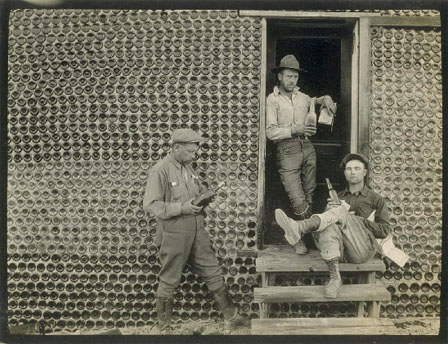
Have you ever thought of recycling as a creative act? To recycle something doesn’t necessarily mean just hauling used bottles, cans and cardboard to the curbside for pickup. Some creative people, either out of need or personal interest have taken the notion of recycling to the next level, using products that would be melted or shredded as whole objects in the construction of creative new buildings.



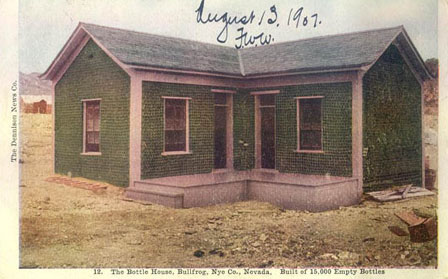
Bottle walls sounds like something a quirky eccentric would construct just for fun. In point of fact, the oldest surviving bottle house was constructed out of over 50,000 beer bottles in 1907, due to the lack of lumber available in the deeserts of Nevada. Though many bottle buildings are decades old, recent structures around the world have been built out of necessity in places where both building supplies are scarce and other recycling methods are unavailable.

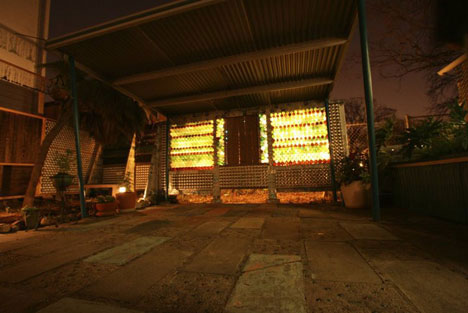
The now-famous Texas beer can house, however, was indeed the result of one man’s eccentricity. What began as one man’s bored urge in the 1960s resulted in a 2-decade, 40,000-can creation that truly is a strange wonder of the world. John, the house’s creator, is survived by his wife Mary, who still invites the public to come and see his amazing creation. John was just an ordinary man who saved beer bottles for years, until he finally came up with a clever way to use them. The latter two images above come via The Beer Can House dot Org.
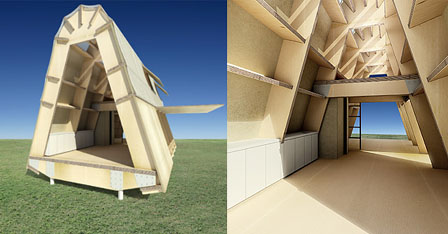
A cardboard house may seem even more implausible than one constructed of beer cans. With the right water-proofing, however, just such a house would be not only sustainable but also exceedingly affordable. This so-called house of the future is designed with exterior waterproofing and water storage under the floor to protect it from the water and from blowing over in the wind. Of course, cardboard is also a highly collapsible building material, making the shipment of the house also more environmentally friendly, efficient and inexpensive.
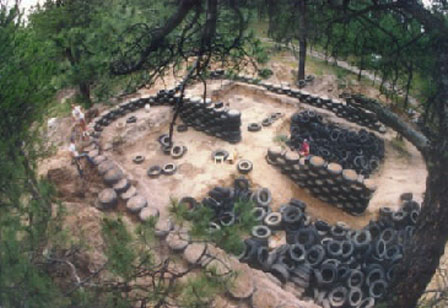
Tire houses are arguably more practical and ultimately realistic than cardboard buildings. Used tires are abundant in our oil-driven world where vehicles are common and changing tires is a fact of life. The thermal mass of a tire wall works well in summer or winter, mitigating the exterior and interior temperatures so the house is never too cold or too hot inside. Construction can also be accomplished by the home owner with relative ease.

Straw Bale House

(Check out our complete collection of 70 Works of Recycled Art and Design.)




Bottle walls sounds like something a quirky eccentric would construct just for fun. In point of fact, the oldest surviving bottle house was constructed out of over 50,000 beer bottles in 1907, due to the lack of lumber available in the deeserts of Nevada. Though many bottle buildings are decades old, recent structures around the world have been built out of necessity in places where both building supplies are scarce and other recycling methods are unavailable.


The now-famous Texas beer can house, however, was indeed the result of one man’s eccentricity. What began as one man’s bored urge in the 1960s resulted in a 2-decade, 40,000-can creation that truly is a strange wonder of the world. John, the house’s creator, is survived by his wife Mary, who still invites the public to come and see his amazing creation. John was just an ordinary man who saved beer bottles for years, until he finally came up with a clever way to use them. The latter two images above come via The Beer Can House dot Org.

A cardboard house may seem even more implausible than one constructed of beer cans. With the right water-proofing, however, just such a house would be not only sustainable but also exceedingly affordable. This so-called house of the future is designed with exterior waterproofing and water storage under the floor to protect it from the water and from blowing over in the wind. Of course, cardboard is also a highly collapsible building material, making the shipment of the house also more environmentally friendly, efficient and inexpensive.

Tire houses are arguably more practical and ultimately realistic than cardboard buildings. Used tires are abundant in our oil-driven world where vehicles are common and changing tires is a fact of life. The thermal mass of a tire wall works well in summer or winter, mitigating the exterior and interior temperatures so the house is never too cold or too hot inside. Construction can also be accomplished by the home owner with relative ease.

Straw Bale House
Straw bale houses also make use of a common and regularly sized material that is relatively available and inexpensive. This regularity makes working with the building blocks relatively easy. Many such houses, once they are completed and covered outside and in, do not even look to be made of straw. Know of other architecture using creatively adapted recyclables (such as shipping container architecture)? Feel free to share in the comments below!
Source: Weburbanist
Wave Effect
by Paul Goldberger
February 1, 2010

Aqua’s undulating façade is even more technically ingenious than it looks.
Aqua—a new, eighty-two-story apartment tower in the center of Chicago—is made of the same tough, brawny materials as most skyscrapers: metal, concrete, and lots of glass. But the architect, Jeanne Gang, a forty-five-year-old Chicagoan, has figured out a way to give it soft, silky lines, like draped fabric. She started with a fairly conventional rectangular glass slab, then transformed it by wrapping it on all four sides with wafer-thin, curving concrete balconies, describing a different shape on each floor. Gang turned the façade into an undulating landscape of bending, flowing concrete, as if the wind were blowing ripples across the surface of the building. You know this tower is huge and solid, but it feels malleable, its exterior pulsing with a gentle rhythm.
The building would be an achievement for any architect, but Gang, who has run her own firm since 1997, had never designed a skyscraper before and happened into this one almost by accident. A couple of years ago, she was seated at a dinner next to Jim Lowenberg, a developer who had built a number of mediocre condominium towers in a huge development over the old Illinois Central rail yards, known as Lakeshore East. A prime site in the project remained, Lowenberg told her, and he envisioned doing something more ambitious there. He liked Gang and offered her a shot. A lot of attention—in Chicago, at least—has been given to the fact that Aqua is the tallest building in the world designed by a woman. That’s nice for Gang, but beside the point, and dwelling on it leads too easily to predictable interpretations of skyscrapers as symbols of male identity. Gang’s achievement has more to do with freeing us from such silliness. Her building is most compelling as an example of architecture that is practical and affordable enough to please real-estate developers and stirring enough to please critics. Not many buildings like that get made at any height, or by architects of either gender.
Furthermore, the success of Aqua isn’t just that Gang figured out a smart, low-budget way of turning an ordinary glass condo tower into something that looks exciting. The design is anchored in common sense in two ways that aren’t immediately apparent, making the building, from a technical point of view, even more remarkable than it looks. The balcony overhangs of the façade serve an environmental purpose, shading apartments from the hot summer sun. More ingenious still, they protect the building from the force of wind, one of the most difficult challenges in skyscraper engineering. The landscape of rolling hills and valleys created by the balconies effectively confuses the heavy Chicago winds, giving them no clear path. The wind is broken up so much that the building didn’t require a device known as a “tuned mass damper”—a mass weighing hundreds of tons that engineers place at the top of tall buildings to stabilize them against the vibrations and sway caused by the force of wind. And using the curves to dissipate the wind gave Gang a bonus: she was able to put balconies on every floor, all the way up. Usually, condominiums sixty or seventy floors above the street don’t have balconies, because it’s just too windy up there to go outside.
When you catch your first glimpse of Aqua’s swirling façade poking out from between its boxy neighbors, you might think it’s a gigantic version of one of those “blob” buildings of the past few years, curvy forms designed largely by computer. But Gang isn’t Greg Lynn or Hani Rashid. She brings aesthetics and engineering together in a way that is more aligned with the tradition of Chicago’s canonical modern architecture than the building’s appearance suggests. Chicago is where architects like Louis Sullivan, John Wellborn Root, Mies van der Rohe, and Skidmore, Owings & Merrill elevated pragmatic solutions to structural problems to the level of art. And that is precisely what Gang has done, albeit with a different aesthetic. For all its visual power, Aqua is mostly free of conceit. In an age in which so much architectural form—even, sometimes, the best architectural form—has no real rationale beyond the fact that it is what the architect felt like doing, there is something admirable about the tower’s lack of arbitrariness. It reclaims the notion that thrilling and beautiful form can still emerge out of the realm of the practical.
In this sense, Gang could not be more different from Zaha Hadid, who is the most famous female architect around. Hadid is a brilliant shaper of form, but her buildings are nothing if not arbitrary, and the combination of her fame and her flamboyant designs has insidiously led people to assume that female architects tend to favor shape-making over problem-solving. In fact, there are plenty of women who have built successful architectural practices by selling themselves not as divas but as purveyors of reason who also happen to be able to make beautiful things. In New York, Deborah Berke, a fifty-five-year-old architect and professor at Yale, directs a firm that has designed hotels, art galleries, academic buildings, houses, and the high-profile 48 Bond Street condominium. (Berke’s Web site describes her work as “simple, not simplistic; elegant, not extravagant; luxurious, not lavish.”) In San Francisco, Cathy Simon founded a firm, SMWM—until a recent merger, it was among the largest women-owned firms in the country—that numbers the restored San Francisco Ferry Building and the San Francisco Public Library among its projects. Marianne McKenna (the “M” in the big Toronto firm KPMB) just finished an acclaimed concert hall at the Royal Conservatory of Music, in Toronto, and has been in charge of a new downtown university campus in Montreal. Denise Scott Brown, of the Philadelphia firm Venturi, Scott Brown & Associates, has been a dominant force in the field of planning and urban design for more than a generation.PHOTOGRAPH: STEVE HALL/HEDRICH BLESSING/COURTESY STUDIO GANG
Source: The New Yorker
New Alberta gallery design will remain 'controversial': architect
The architect who designed the new Art Gallery of Alberta says he doesn't mind that some people won't like the new building, which opens Sunday. "I think it will probably always remain somewhat controversial," said Randall Stout, who won the competition to design the building in 2005 and was in Edmonton for the grand opening.
"If you're going to do something new and you're going to push the envelope, there will always be folks … [taking sides] on whether they appreciate that or not."
Stout said his firm in Los Angeles built a model of 12 blocks of downtown Edmonton to determine whether the design would fit with neighbouring buildings.
After studying the model, changes were made so the structure wouldn't overwhelm its surroundings, he said.
 The new Art Gallery of Alberta opens to the public Sunday, but tickets for the two-day opening celebration are sold out. (CBC)Stout believes the finished product fits appropriately and has the right sightlines from neighbouring buildings.
The new Art Gallery of Alberta opens to the public Sunday, but tickets for the two-day opening celebration are sold out. (CBC)Stout believes the finished product fits appropriately and has the right sightlines from neighbouring buildings.
"It has its own obvious presence; yet, it's a part of the context of the greater whole," Stout said on CBC Radio's Edmonton AM.
The signature features of the building are the waves of metal that define the southwest aspect of the gallery, which Stout's firm nicknamed "the borealis."
"The idea of nicknaming it the borealis is not meant to be a literal one-liner 'That's the only way it can be interpreted'," Stout said. "I've had other people say they see different things."
 The view from inside the new Art Gallery of Alberta. (CBC) There are no exterior lights on the building, Stout said, so "in the evening, it becomes a beacon of light."
The view from inside the new Art Gallery of Alberta. (CBC) There are no exterior lights on the building, Stout said, so "in the evening, it becomes a beacon of light."
"What we do is we light the underside of that borealis form so that the building glows from within."
The gallery opens with three main exhibits, featuring prints by Franciso Goya; sculpture by Edgar Degas; and photographs by Yousouf Karsh.
There are no more tickets available for the two-day opening celebration or for Family Day, Feb. 15.
Source : CBC
"If you're going to do something new and you're going to push the envelope, there will always be folks … [taking sides] on whether they appreciate that or not."
Stout said his firm in Los Angeles built a model of 12 blocks of downtown Edmonton to determine whether the design would fit with neighbouring buildings.
After studying the model, changes were made so the structure wouldn't overwhelm its surroundings, he said.
 The new Art Gallery of Alberta opens to the public Sunday, but tickets for the two-day opening celebration are sold out. (CBC)Stout believes the finished product fits appropriately and has the right sightlines from neighbouring buildings.
The new Art Gallery of Alberta opens to the public Sunday, but tickets for the two-day opening celebration are sold out. (CBC)Stout believes the finished product fits appropriately and has the right sightlines from neighbouring buildings."It has its own obvious presence; yet, it's a part of the context of the greater whole," Stout said on CBC Radio's Edmonton AM.
The signature features of the building are the waves of metal that define the southwest aspect of the gallery, which Stout's firm nicknamed "the borealis."
"The idea of nicknaming it the borealis is not meant to be a literal one-liner 'That's the only way it can be interpreted'," Stout said. "I've had other people say they see different things."
 The view from inside the new Art Gallery of Alberta. (CBC) There are no exterior lights on the building, Stout said, so "in the evening, it becomes a beacon of light."
The view from inside the new Art Gallery of Alberta. (CBC) There are no exterior lights on the building, Stout said, so "in the evening, it becomes a beacon of light.""What we do is we light the underside of that borealis form so that the building glows from within."
The gallery opens with three main exhibits, featuring prints by Franciso Goya; sculpture by Edgar Degas; and photographs by Yousouf Karsh.
There are no more tickets available for the two-day opening celebration or for Family Day, Feb. 15.
Source : CBC
Subscribe to:
Posts (Atom)

